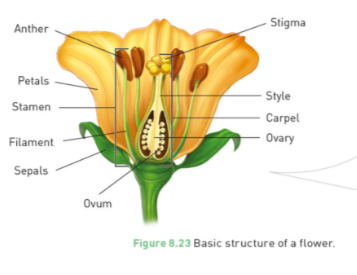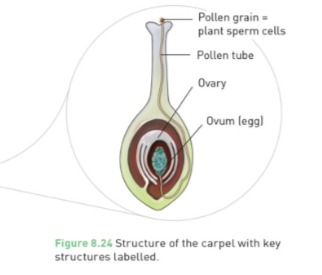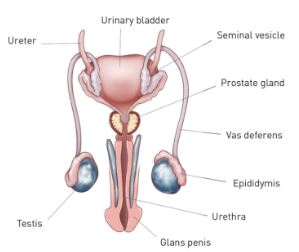Year 8 - Reproduction & Physics!
0.0(0)
Card Sorting
1/29
Study Analytics
Name | Mastery | Learn | Test | Matching | Spaced |
|---|
No study sessions yet.
30 Terms
1
New cards
The scientific term for 'making new organisms' is reproduction.
What is the scientific term for 'making new organisms'?
2
New cards
A gamete is a reproductive cell found in animals and plants.
What is a gamete?
3
New cards
Animal female gametes are called eggs and male gametes are called sperm.
What are the names for the two gametes in animals?
4
New cards
Plant male gametes are called pollen and female gametes are called ovum.
What are the names of the two gametes in plants?
5
New cards
Sexual reproduction produces more variation in offspring because the genetic material (DNA) comes from parents with different cells and two different species.
Which produces more variation in offspring: sexual or asexual? Why?
6
New cards
Self-pollination occurs when pollen from a plant fertilises the egg on the same plant. Cross-pollination occurs when pollen from one plant fertilises the egg from another plant. Cross-pollination is better for biodiversity as the reproduction process includes two plants.
Explain the difference between self-pollination and cross-pollination. Which one is better for biodiversity?
7
New cards
Binary fission is when an organism duplicates its DNA and then divides it into two. Bacteria reproduce this way.
Describe binary fission and give an example of an organism reproducing this way.
8
New cards
Budding is when a new organism develops from the bud of an existing organism. Hydra reproduce this way.
Describe budding and give an example of an organism reproducing this way.
9
New cards
Parthenogenesis is when the production of offspring occurs in the absence of a male. A reticulated python reproduced this way.
Describe parthenogenesis and give an example of an organism reproducing this way.
10
New cards
Fragmentation is when a fragment of the parent breaks off and develops. Starfish reproduce this way.
Describe fragmentation and give an example of an organism that reproduces this way.
11
New cards

Asexual reproductive system.
Asexual reproductive system.
12
New cards

In depth asexual reproductive system.
In depth asexual reproductive system.
13
New cards

Female reproductive system.
Female reproductive system.
14
New cards

Male reproductive system.
Male reproductive system.
15
New cards
Kinetic
_______ energy is energy in all moving objects.
16
New cards
Nuclear
________ energy is used widely throughout the world to generate electricity from atoms.
17
New cards
Potential
___________ energy is another name for stored energy.
18
New cards
Elastic
_________ energy is the energy stored in a compressed string.
19
New cards
Gravitiational
________ energy is the energy of an object when lifted off the ground.
20
New cards
Kinetic energy.
State the main form of energy in the following:
Water flowing slowly over a waterfall.
Water flowing slowly over a waterfall.
21
New cards
Kinetic energy.
State the main form of energy in the following:
A roller coaster at the lowest point of the ride.
A roller coaster at the lowest point of the ride.
22
New cards
Light energy.
State the main form of energy in the following:
The Sun coming in through a window.
The Sun coming in through a window.
23
New cards
Kinetic energy.
State the main form of energy in the following:
A boy riding his skateboard.
A boy riding his skateboard.
24
New cards
Elastic potential energy.
State the main form of energy in the following:
A stretched rubber band.
A stretched rubber band.
25
New cards
Light bulb.
Name a device that transforms:
Electrical energy -> Light energy.
Electrical energy -> Light energy.
26
New cards
Rubber band.
Name a device that transforms:
Elastic energy -> Kinetic energy.
Elastic energy -> Kinetic energy.
27
New cards
Television.
Name a device that transforms:
Electrical energy -> Sound energy.
Electrical energy -> Sound energy.
28
New cards
Generator
Name a device that transforms:
GPE -> Electrical energy.
GPE -> Electrical energy.
29
New cards
Turbines.
Name a device that transforms:
Kinetic energy -> Electrical energy.
Kinetic energy -> Electrical energy.
30
New cards
Energy can neither be created or destroyed. It can only be transformed or transferred.
State the law of conservation of energy.